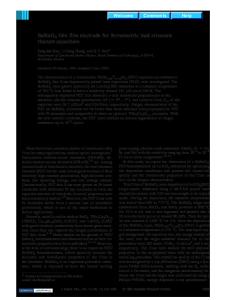Transient Behavior of the Polarization in Ferroelectric Thin Film Capacitors
- PDF / 170,930 Bytes
- 9 Pages / 612 x 792 pts (letter) Page_size
- 96 Downloads / 311 Views
Transient Behavior of the Polarization in Ferroelectric Thin Film Capacitors Oliver Lohse1, Michael Grossmann1, Dierk Bolten1, Ulrich Boettger1, and Rainer Waser2 1 IWE II, RWTH University of Technology, 52056 Aachen, Germany 2 FZJ Research Center Juelich, 52425 Juelich, Germany ABSTRACT The understanding of the polarization switching process of ferroelectric capacitors is highly relevant for the development and optimization of FeRAM devices. We report on the characterization of Pb(Zr,Ti)O3 thin films which have been studied by means of dedicated rectangle pulse measurements. Decreasing the voltage level of the excitation pulses decelerates the polarization switching significantly to the range of milliseconds and reduces the switchable polarization. In this work the influence of niobium (Nb) doping on the switching properties of PZT thin films prepared by CSD are investigated to reach the aspired conditions of low voltage operation, read and write access pulses in the range of nanoseconds. For the implementation of the transient behavior of ferroelectric capacitors in circuit design and simulation tools it is necessary to develop a model which precisely describes the polarization hysteresis, the pulse switching behavior as well as the small signal capacitance. The fundamental considerations for this model are presented, based on an ideal ferroelectric capacitor, taking into account the Curie-von Schweidler behavior. The latter is observed in non-ferroelectric high-K materials as well as in ferroelectric thin films. INTRODUCTION Thin films of perovskite materials such as lead zirconate titanate (PZT) [1] and layered perovskites such as strontium bismuth tantalate (SBT) [2] are being intensively studied for their application in high density ferroelectric random access memories (FeRAM) integrated circuits [3]. In addition to processing issues of integrating these materials in semiconductor technology, the ferroelectric properties and their reliability are of major interest. In comparison to non-ferroelectric barium strontium titanate (BST), where the dielectric relaxation has been extensively explored [4], relaxation in ferroelectric materials has not yet received the attention it deserves. In this work the voltage step characterization is exploited to elucidate the origin of relaxation in ferroelectric materials for the fast read and write access of the memory cell. The intrinsic switching time of the reversal in ferroelectric thin films is assumed to be below nanoseconds [5,6]. These times are only obtained when voltages much higher then the coercitive voltage are instantaneously applied. For low voltage levels, the switching process can be very slow. This is of great interest for the application in fast access memories, since it can in principle limit the access time of the memory cell, especially, in the desired low voltage operation range. To remind the reader of the empirical equations found by W. Merz [7] which can describe the current response during a polarization reversal in ferroelectric single crystals, typ
Data Loading...











